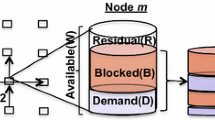Abstract
The connectivity of wireless networks is commonly analyzed using static geometric graphs. However, with half-duplex radios and due to interference, static or instantaneous connectivity cannot be achieved. It is not necessary, either, since packets take multiple time slots to propagate through the network. For example, if a packet traverses a link in one time slot, it is irrelevant if the next link is available in that time slot also, but it is relevant if the next hop exists in the next time slot. To account for half-duplex constraints and the dynamic changes in the transmitting set of nodes due to MAC scheduling and traffic loads, we introduce a random multi-digraph that captures the evolution of the network connectivity in a dynamic fashion. To obtain concrete results, we focus on Poisson networks, where transmitters form a Poisson point process on the plane at all time instants. We first provide analytical results for the degree distribution of the graph and derive the distributional properties of the end-to-end connection delay using techniques from first-passage percolation and epidemic processes. Next, we prove that under some assumptions, the delay scales linearly with the source–destination distance even in the presence of interference. We also provide simulation results in support of the theoretical results.







Similar content being viewed by others
Notes
In a real system, the link distance depends on the receiver sensitivity, the path-loss exponent, and fading. However, the presence of noise is sufficient to cause the connectivity radius to be finite
References
Agarwal, A., Starobinski, D., & Little, T.D.C. (2012). Phase transition of message propagation speed in delay-tolerant vehicular networks. IEEE Transactions on Intelligent Transportation Systems, 13(1), 249–263.
Aldous, D., & Steele, J. (2003). In H. Kesten (Ed.) Probability on discrete structures (Encyclopaedia of mathematical sciences (Vol. 110)). Springer.
Baccelli, F., & Blaszczyszyn, B. (2009). Stochastic geometry and wireless networks, part II: Applications. Hanover: Now Publishers Inc.
Balister, P., Bollobás, B., & Walters, M. (2005). Continuum percolation with steps in the square of the disc. Random Structures and Algorithms, 26(4), 392–403.
Dousse, O., Franceschetti, M., Macris, N., Meester, R., & Thiran, P. (2006). Percolation in the signal to interference ratio graph. Journal of Applied Probability, 43, 552–562.
Dousse, O., Mannersalo, P., & Thiran, P. (2004). Latency of wireless sensor networks with uncoordinated power saving mechanisms. In Proceedings of the 5th ACM international symposium on mobile ad hoc networking and computing (pp. 109–120).
Durrett, R. (1999). Stochastic spatial models. Siam Review, 41, 677–718.
Ganti, R., & Haenggi, M. (2007). Dynamic connectivity and packet propagation delay in ALOHA wireless networks. In Forty-first asilomar conference on signals, systems and computers. (ACSSC 2007) (pp. 143–147). IEEE
Ganti, R., & Haenggi, M. (2009) Bounds on information propagation delay in interference-limited ALOHA networks. In Workshop on spatial stochastic models for wireless networks (SPASWIN)
Ganti, R., & Haenggi, M. (2010). Limit of the transport capacity of a dense wireless network. Journal of Applied Probability, 47(3), 886–892.
Gilbert, E. (1961). Random plane networks. Journal of the Society for Industrial Applied Mathematics, 9, 533–543.
Gupta, P., & Kumar, P. (2000). The capacity of wireless networks. IEEE Transactions on Information Theory, 46(2), 388–404.
Haenggi, M. (2005). On distances in uniformly random networks. IEEE Transactions on Information Theory, 51(10), 3584–3586.
Haenggi, M. (2012). Stochastic geometry for wireless networks. New York: Cambridge University Press.
Hammersley, J., & Welsh, D. (1965) First-passage percolation, subadditive processes, stochastic networks, and generalized renewal theory. Bernoulli–Bayes–Laplace anniversary volume (pp. 61–110).
Jacquet, P., Mans, B., Muhlethaler, P., & Rodolakis, G. (2009). Opportunistic routing in wireless ad hoc networks: Upper bounds for the packet propagation speed. IEEE Journal on Selected on Areas in Communications, 27(7), 1192–1202.
Jacquet, P., Mans, B., & Rodolakis, G. (2010). Information propagation speed in mobile and delay tolerant networks. IEEE Transactions on Information Theory, 56(10), 5001–5015.
Kesten, H. (1986). Aspects of first passage percolation. Lecture Notes in Mathematics, 1180, 125–264.
Kingman, J. (1973). Subadditive Ergodic theory. The Annals of Probability, 1(6), 883–899.
Kong, Z., & Yeh, E. (2009). Connectivity, percolation, and information dissemination in large-scale wireless networks with dynamic links. Arxiv preprint arXiv:0902.4449
Kumar, P., & Xue, F. (2006) . Scaling laws for ad-hoc wireless networks: An information theoretic approach. Hanover: Now Publishers Inc.
Mollison, D. (1977). Spatial contact models for ecological and epidemic spread. Journal of the Royal Statistical Society. Series B (Methodological), 39(3), 283–326.
Mollison, D. (1978). Markovian contact processes. Advances in Applied Probability, 10(1), 85–108.
Zhang, X., Neglia, G., Kurose, J., & Towsley, D. (2007). Performance modeling of epidemic routing. Computer Networks, 51(10), 2867–2891.
Acknowledgments
The partial support of the NSF (grants CNS 1016742 and CCF 1216407) and the DARPA/IPTO IT-MANET program (grant W911NF-07-1-0028) is gratefully acknowledged.
Author information
Authors and Affiliations
Corresponding author
Rights and permissions
About this article
Cite this article
Ganti, R.K., Haenggi, M. Dynamic connectivity and path formation time in Poisson networks. Wireless Netw 20, 579–589 (2014). https://doi.org/10.1007/s11276-013-0620-y
Published:
Issue Date:
DOI: https://doi.org/10.1007/s11276-013-0620-y




